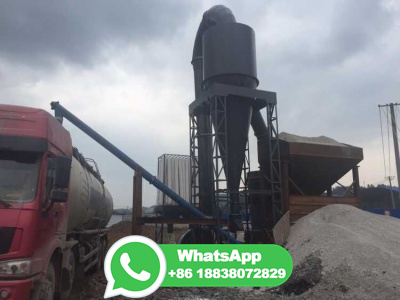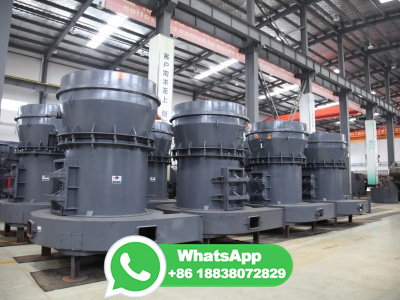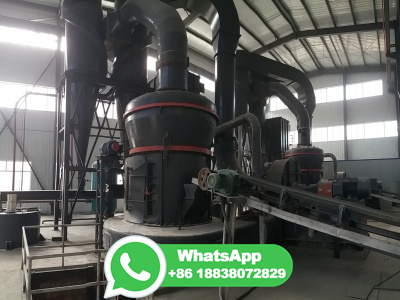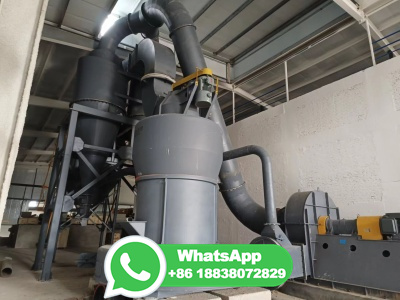
WEBMar 1, 2003 · The standard ball mill Bond grindability testThe standard Bond grindability test is a closedcycle dry grinding and screening process, which is carried out until steady state condition is obtained. This test has been described as follows (Bond and Maxson, 1943; Yap et al., 1982; Austin and Brame, 1983; Magdalinovic, 1989).
WhatsApp: +86 18203695377
WEBOver the years, alternative procedures to the Bond grindability test have been proposed aiming to avoid the need for the standard mill or to reduce and simplify the grinding procedure. Some of them use the standard mill, while others are based on a ... A Review of Alternative Procedures to the Bond Ball Mill Standard Grindability Test.
WhatsApp: +86 18203695377
WEBDOI: / Corpus ID: ; Product size distribution function influence on interpolation calculations in the Bond ball mill grindability test article{Rodrguez2016ProductSD, title={Product size distribution function influence on interpolation calculations in the Bond ball mill grindability test}, author={Beatriz .
WhatsApp: +86 18203695377
WEBExperimental The standard rod mill grindability test (Bergstrom, 1985) was conducted with four ores, ranging from very soft to very hard. Briefly, the test consists of placing a bulk volume of ore measuring 1250 ml, previously stagecrushed to mm in the standard mill (305 mm diameter u0003 610 mm length) fitted with wavy liners, along ...
WhatsApp: +86 18203695377
WEBJun 1, 2000 · While a number of methods have been proposed in the literature (Yap et al., 1982; et al., 1990; Aksani and Sönmez, 2000) to simulate the traditional Bond ball mill test, in the case of the ...
WhatsApp: +86 18203695377
WEBBond Work Index Test Ball Mill. US 14,500. The FC Bond Work Index Test Ball Mill was designed by F. C. Bond for use in determining the Bond Index, a measure of grindability and power required for grinding appliions. The FC Bond Mills are used in laboratories throughout the world. A copy of Fred C. Bond's Method of Crushing and .
WhatsApp: +86 18203695377
WEBNov 21, 2012 · Introduction. The Bond grindability test for determining the Bond work index, W i, is conducted in a Bond ball mill having the dimensions D × L = 305 × 305 mm and a speed revolution of 70 min − mill is loaded with balls from up to mm in diameter, having thus a total mass of kg.. This test simulates a closed circuit .
WhatsApp: +86 18203695377
WEBJan 3, 2020 · There are many tests for determining grindability. The most commonly used test is the Bond ball mill (BBM). It enables the installation of a plant scale ball mill . The Bond work index test is used to measure the energy required for the desired particle size reduction and for designing new circuits for comminution .
WhatsApp: +86 18203695377
WEBApr 1, 2008 · The standard laboratory grindability tests can be applied to the grinding of materials in a relatively coarse particle size interval (Bond method: x < mm, Hardgrove: x = – mm ...
WhatsApp: +86 18203695377
WEBThe effect of ball load composition, by varying the grinding media size distribution ( alternatively by mixing four groups of, 38 mm;, 50 mm; 38, 50 mm and, 38, 50 mm), on the ...
WhatsApp: +86 18203695377
WEBJul 22, 2021 · Alternative procedure to the Bond standard test is based on determining the grindability of an unknown ore by comparing it to the grindability behaviour of a reference ore. It can be performed in any laboratory ball mill, but it requires a reference sample ore for which wi is known. grindability comminution Bond work index. 1. Introduction ...
WhatsApp: +86 18203695377
WEBMar 30, 2022 · The ball mill grindability test, which is similar to the Bond grindability test, was first introduced by Maxson, Cadena and Bond in 1933 (Maxson et al., 1933). Later, F. Bond developed a new grindability test as the Bond grindability Index as a method in 1956 with both different mill diameter and different material and ball load.
WhatsApp: +86 18203695377
WEBA Review of Alternative Procedures to the Bond Ball Mill Standard Grindability Test
WhatsApp: +86 18203695377
WEBJan 31, 2012 · The Bond rod mill grindability test is a widely used tool to estimate the response of ores to rod milling. However, the mass of ore required to conduct the test, which can typically vary from ...
WhatsApp: +86 18203695377
WEBSep 1, 2006 · The new grindability test with heated Bond . mill is suitable for making experiments under . ... 2004(Csőke et al.,, 2005a and the Universal Bond ball mill (Mucsi et al., 2006) ...
WhatsApp: +86 18203695377
WEBThe ball mill grindability test is used for describing ore hardness and it is so widespread that the Bond Work Index generated from the test is often referred to as an ore characteristic. The ore ...
WhatsApp: +86 18203695377
WEBOct 12, 2022 · the Bond Ball Mill Grindability Test. The main differ ence that was being investigated was the . impact of using a testing mill with a 4inchX8inch hand hole door in the shell versus a mill with .
WhatsApp: +86 18203695377
WEBSemantic Scholar extracted view of "Simulating the Bond rod mill grindability test" by L. M. Tavares et al. ... Product size distribution function influence on interpolation calculations in the Bond ball mill grindability test. B. Á. Rodríguez G. G. García Alfredo L. CoelloVelázquez J. M. MenéndezAguado. Engineering, Materials Science ...
WhatsApp: +86 18203695377
WEBFeb 1, 2013 · In spite of the important developments in recent decades with improved characterization, modeling and simulation approaches applied to ball mills (Austin et al., 1984, Herbst and Fuerstenau, 1980, Tavares and Carvalho, 2009), the Bond ball mill grindability test retains a significant part of its original importance as a convenient and ...
WhatsApp: +86 18203695377
WEBJan 1, 2012 · The Bond rod mill work index ( Wir) is measured using Bond´s standard rod mill grindability test, which is conducted in lockedcycle mode to emulate the continuous closedcircuit operation. Besides the laborintensive conduct of the test, which typically requires from 5 to 10 cycles for reaching steadystate, it normally requires 8–20 kg of ...
WhatsApp: +86 18203695377
WEBFigure 2: the working principle of ball mill Figure 1: type of ball use In this experiment, the Work Index is calculated from the following equation based on Bond,s third theory equation: Where = Work index (kWh/ton) = Test sieve aperture (micrometer) = Grindability (g/revolution) Figure 3: ball mill = 80% passing size of feed (micrometer) = 80 ...
WhatsApp: +86 18203695377
WEBThe test procedure for the first series of grinding tests follows the wellknown Bond ball mill grindability test [2,23] precisely. In the Bond ball milling test, a lockedcycle test, the fresh feed to the test is crushed down to under mm. The mill grinds a constant 700 mL of ore. After each grind, the mill contents are screened to ...
WhatsApp: +86 18203695377
WEBNov 21, 2012 · 1. Introduction. The Bond grindability test for determining the Bond work index, W i, is conducted in a Bond ball mill having the dimensions D × L = 305 × 305 mm and a speed revolution of 70 min − mill is loaded with balls from up to mm in diameter, having thus a total mass of kg.. This test simulates a closed circuit .
WhatsApp: +86 18203695377
WEBAug 10, 2016 · The duration of one batch measurement is 3 min as in the original test. Universal Bond ball mill. The traditional Bond grindability test (Bond, 1961) is carried out under simplified circumstances in a special dry batch mill, with defined feed size material, until the prescribed grinding fineness is reached at room temperature.
WhatsApp: +86 18203695377
WEBThe clinker samples collected also undergone standard Bond grindability test. The objective of the Bond ball mill test is to determine the socalled standard work index, which is defined as the specific power required to reduce a material from a notional infinite size to a P80 size of 1O~m.
WhatsApp: +86 18203695377
WEBAug 5, 2005 · This was done by means of the Bond Ball Mill Standard test [24][25] [26]. In brief, with the aim to simulate closed circuit continuous operation with a recirculating load of 250%, the test [27] is ...
WhatsApp: +86 18203695377
WEBOct 1, 2001 · The ball mill grindability test is used for describing ore hardness and it is so widespread that the Bond Work Index generated from the test is often referred to as an ore characteristic. The ore resistance to grinding and energy consumption can be expressed using the work index and Bond's Third Theory. The Bond Third Theory method is widely ...
WhatsApp: +86 18203695377
WEBOver the years, alternative procedures to the Bond grindability test have been proposed aiming to avoid the need for the standard mill or to reduce and simplify the grinding procedure. Some of them use the standard mill, while others are based on a nonstandard mill or computation techniques.
WhatsApp: +86 18203695377